Apple 15-inch MacBook Pro (Late 2011) Review
by Anand Lal Shimpi on November 17, 2011 5:10 PM EST- Posted in
- Mac
- Apple
- Intel
- MacBook Pro
- Sandy Bridge
- Laptops
The early 2011 MacBook Pro is honestly Apple's best effort to date. Only using quad-core CPUs on the 15 and 17-inch models, and offering an optional Thunderbolt Display that can act as a modern day dock makes this platform, particularly the 15-inch model, the perfect candidate for users who want the power and flexibility of a desktop with the portability of a notebook. Apple gets the mobile revolution in more ways than one, and its MacBook Pro/Thunderbolt Display combo is the perfect example of that.
It's this very combination that I've been using, partially since the introduction of the Sandy Bridge MacBook Pro earlier this year (the Thunderbolt Display didn't arrive until later). I've been quite happy with the setup. With the exception of lackluster Quick Sync adoption by Apple and obviously limited GPU options, I have very few major complaints.
Late last month, Apple updated its 2011 MacBook Pro lineup - likely the first and last update before Apple adopts Ivy Bridge in Q2 next year. We got our hands on the new base 15-inch MacBook Pro configuration, which received one of the more substantial upgrades over the previous model. As this is still a fairly minor upgrade, be sure to read our original review of the platform for a deeper dive into all of the aspects of the system.
| Late 2011 MacBook Pro Lineup | |||||||
| 13-inch (low end) | 13-inch (high end) | 15-inch (low end) | 15-inch (high end) | 17-inch | |||
| Dimensions |
0.95 H x 12.78 W x 8.94 D
|
0.95 H x 14.35 W x 9.82 D
|
0.98 H x 15.47 W x 10.51 D
|
||||
| Weight |
4.5 lbs (2.04 kg)
|
5.6 lbs (2.54 kg)
|
6.6 lbs (2.99 kg)
|
||||
| CPU |
2.4 GHz dual-core Core i5
|
2.8 GHz dual-core Core i7
|
2.2 GHz quad-core Core i7
|
2.4 GHz quad-core Core i7
|
2.4 GHz quad-core Core i7
|
||
| GPU |
Intel HD 3000 Graphics
|
Intel HD 3000 + AMD Radeon HD 6750M (512MB)
|
Intel HD 3000 + AMD Radeon HD 6770M (1GB)
|
Intel HD 3000 + AMD Radeon HD 6770M (1GB)
|
|||
| RAM |
4GB 1333MHz DDR3 (8GB max)
|
||||||
| HDD |
500GB 5400 RPM
|
750GB 5400 RPM
|
500GB 5400 RPM
|
750GB 5400 RPM
|
750GB 5400 RPM
|
||
| Display Resolution |
1280x800
|
1440x900 (1680x1050 optional)
|
1920x1200
|
||||
| Ports |
Gigabit LAN, Firewire 800, Thunderbolt, 2x USB 2.0, SDHC slot, combined audio in/out jack
|
Gigabit LAN, Firewire 800, Thunderbolt, 2x USB 2.0, SDHC slot, separate audio in/out jacks
|
Gigabit LAN, Firewire 800, Thunderbolt, 3x USB 2.0, separate audio in/out jacks, ExpressCard 34 slot
|
||||
| Battery Capacity |
63.5Wh
|
77.5Wh
|
95Wh
|
||||
| Price | $1,199 | $1,499 | $1,799 | $2,199 | $2,499 | ||
Silicon Updates
The focus of Apple's late 2011 update, despite rumors to the contrary, was on the silicon inside the platform. As the Mac business is a relatively mature one, we can expect a slower pace of chassis and design upgrades compared to the iPhone/iPad businesses for example.
We'll start with the CPU, the lesser updated chip in the new MacBook Pro. System pricing hasn't changed, but CPU speeds have all gone up.
Just as before the 15-inch MacBook Pro is only available with a quad-core Intel Core i7 CPU (codename Sandy Bridge). The $1799 configuration goes from a 2.0GHz i7 to a 2.2GHz model. Be warned, this isn't the same 2.2GHz model that was available as an upgrade earlier this year though.
A quick run of Cinebench points out that the 2.2GHz i7 in our system may be a Core i7 2675QM. The original 2.2GHz option was a Core i7 2720QM. What's the difference between the two? Not a whole lot.

Max turbo is down a bit on the 2675QM. It was 3.3GHz on the 2720, but now it's 3.1GHz. The two, three and four core turbo limits are also down by 200MHz compared to what they were in early 2011. If you didn't have a 2.2GHz early 2011 15-inch MacBook Pro, these differences likely don't mean anything. If for whatever reason you're comparing to an early 2011 2.2GHz model, you'll see a slight regression in CPU bound performance.
The on-die GPU is a hair slower as well. You still get an Intel HD 3000 GPU (12 EUs) but the max turbo moves from 1.3GHz down to 1.2GHz. Or if you prefer another way of looking at it, the 2675QM is the same as the 2670QM, except the GPU is able to clock 100MHz higher (1.2GHz vs. 1.1GHz).
| Apple 15-inch Late 2011 MacBook Pro CPU Comparison | |||||
| 2.2GHz quad-core | 2.4GHz quad-core | 2.5GHz quad-core | |||
| Intel Model | Core i7-2675QM | Intel Core i7-2760QM | Intel Core i7-2860QM | ||
| Base Clock Speed | 2.2GHz | 2.4GHz | 2.4GHz | ||
| Max SC Turbo | 3.1GHz | 3.5GHz | 3.6GHz | ||
| Max DC Turbo | 3.0GHz | 3.4GHz | 3.5GHz | ||
| Max QC Turbo | 2.8GHz | 3.2GHz | 3.3GHz | ||
| L3 Cache | 6MB | 6MB | 8MB | ||
| AES-NI | Yes | Yes | Yes | ||
| VT-x | Yes | Yes | Yes | ||
| VT-d | No | Yes | Yes | ||
| TDP | 45W | 45W | 45W | ||
The upgraded 15-inch configuration comes with an all new Sandy Bridge SKU: the Core i7 2760QM running at 2.4GHz. Unlike the old 2.3GHz part, the 2760QM still only has a 6MB L3 cache. You do get higher base and turbo speeds. There's also a new 2.5GHz quad-core option that can run at up to 3.6GHz with a single core active. That's an absolutely insane frequency for a notebook. Notebook-as-a-desktop users will appreciate the flexibility here.
All of the new CPUs support AES-NI, although once again Apple is the victim of Intel's silly segmentation. The entry level 2.2GHz part does not support VT-d (Virtualization Technology for Directed I/O), which allows virtual machines to have direct access to I/O devices (including PCIe GPUs). I'm not sure if any current virtualization software for OS X supports VT-d, but the absence of the feature is important to note nonetheless. The rest of the CPU lineup supports VT-d.

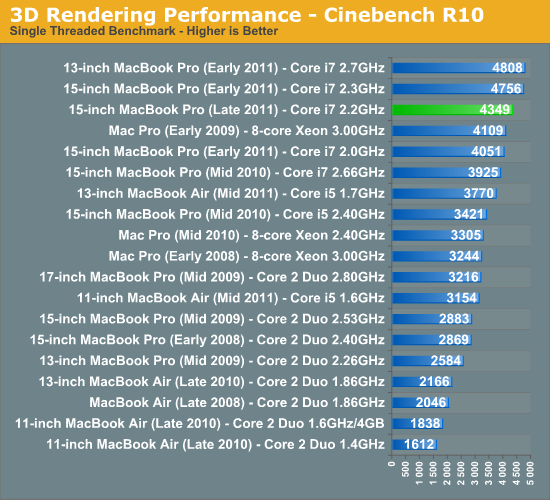
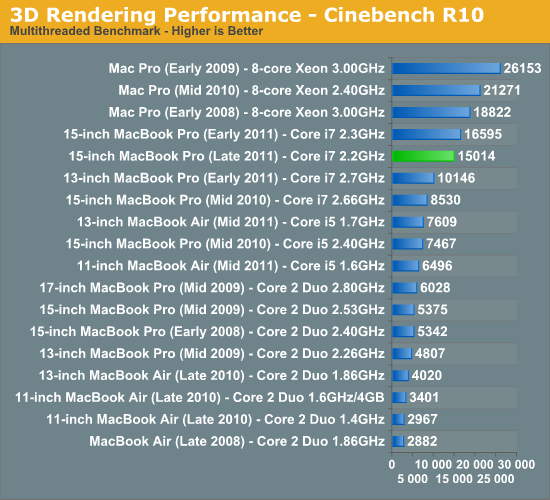
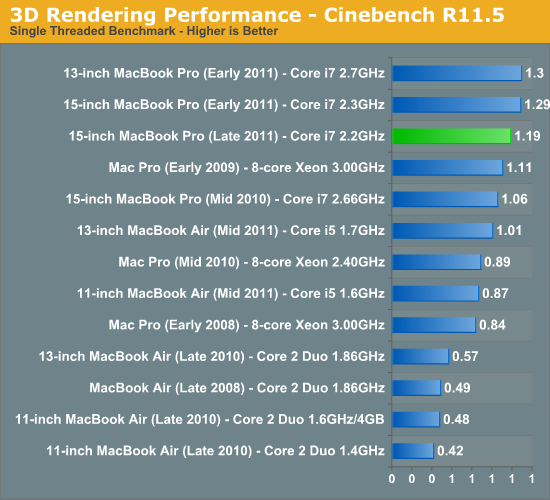
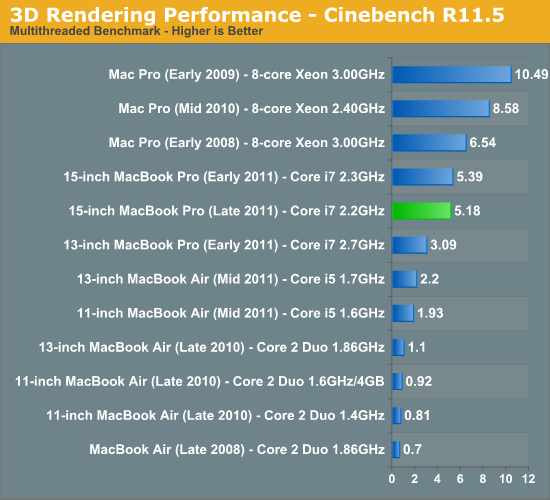
Battery Life
TDPs haven't changed, nor has the MacBook Pro's battery capacity, so overall battery life should (and does) remain relatively unchanged from the early 2011 models. Worst case scenario you can expect around 2.5 hours of battery life under load. With moderate load expect 4 - 5 hours of use on a single charge. And under a very light load you can easily exceed 7 hours.
I ran our normal battery life suite, however Lion has made some of the numbers a little less comparable than I would've liked. The lighter use cases (e.g. our web browsing tests) see a drop compared to our older Snow Leopard results. Under full load the new platform, even while running Lion, actually did a bit better than its predecessor. All in all I'd say the new MacBook Pro is pretty consistent with its predecessor - Lion just threw a wrench in a lot of our battery life comparisons so we'll be starting over from scratch in building our new database.
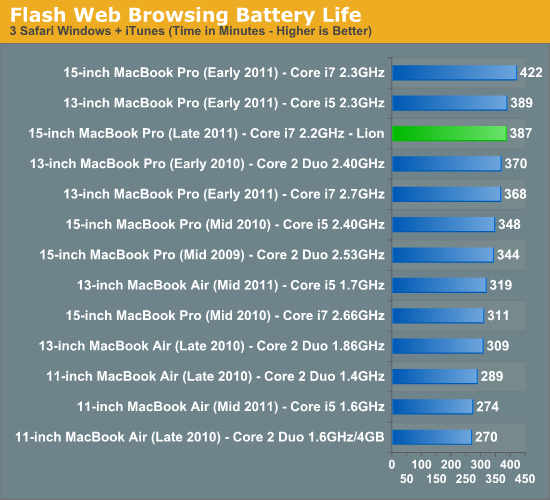
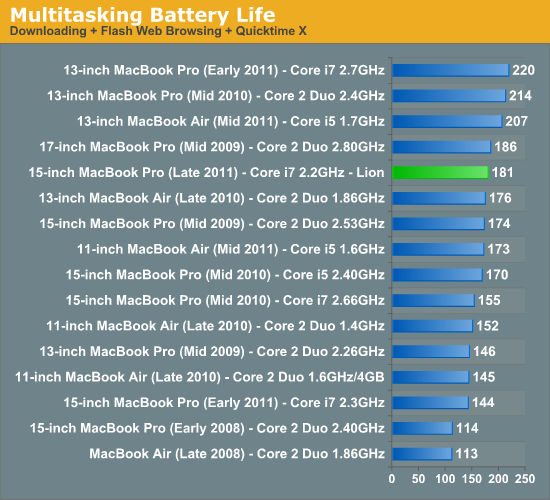


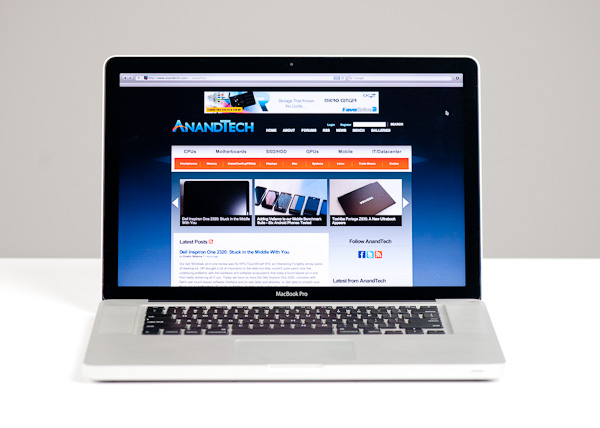
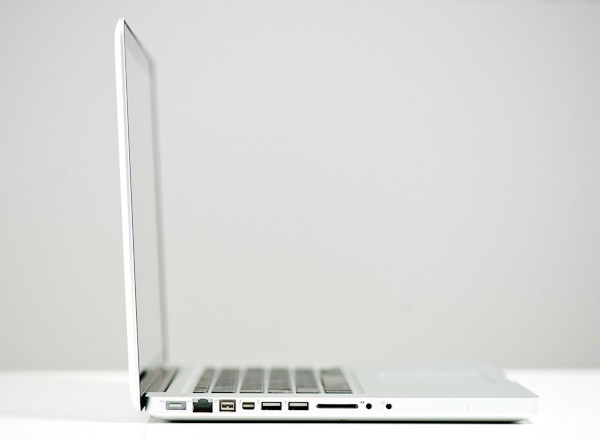
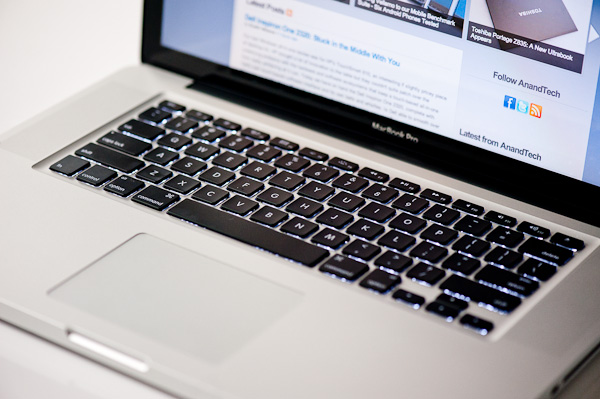








101 Comments
View All Comments
gradjoh - Thursday, November 17, 2011 - link
If I read the charts correctly, then the new "late 2011" model is slower in every category than the "early 2011" model??Zellias - Thursday, November 17, 2011 - link
Since when have mac users been focused on performance? If you're concerned about performance buy a PC and save yourself some time and money.KoolAidMan1 - Thursday, November 17, 2011 - link
High end MBPs have generally been on the high end of performance. Fanboys threw a shitfit a few years ago when PCMag rated the MBP as the fastest PC laptop, barely edging out an HP (I think it was an Elitebook).You're paying for that performance in a thin and light package with good battery life. Compromise on any of those as well as the display, the keyboard, and the trackpad, and it's easy to get a cheaper laptop from someone else.
arterius2 - Thursday, November 17, 2011 - link
Bug off iFanyboy, fastest PC laptop? you make me laugh, my 2 year old Asus G73 with an intel SSD rapes the living sh1t out of this POS. I been playing Starcraft II @ 1920x1080 on high setting with 40+fps with this laptop at less than half the price of the macbookpro.thin and light package? do you even know the crap you spew out of your mouth? macbook pro is far from light, in fact its quite heavy for its class due to being carved entirely out of a block of metal.
Flunk - Thursday, November 17, 2011 - link
Nice troll, missing the point entirely is the way to go!KoolAidMan1 - Thursday, November 17, 2011 - link
Wow, so mad!See, this is what I talk about when it comes to angry fanboys. Newsflash: these machines all have most of the same guts, a quad core i7 in my case.
And my POS MBP runs Starcraft 2 at over 60fps on high and over 200fps on low (pro style) at the same resolution.
As far as weight goes, 5.6 lbs is extremely light given that notebooks with the same display size and power are generally over 6lbs and generally around 8lbs.
GG
KoolAidMan1 - Thursday, November 17, 2011 - link
Also, there seem to be serious reading comprehension issues here. The PCMag example I gave was ONE example where the MBP (I believe it was the Penryn launch) was actually the fastest notebook for a time. Obviously it isn't always the fastest, thermal limitations and the chassis size are always going to place a limit on that.The point still seems to stand though, say that the 15" MBP is actually fast hardware, or sometimes even the fastest, and some people go ballistic.
JarredWalton - Friday, November 18, 2011 - link
The MBP has never been the fastest notebook around. Ever. It has (debatably) been one of the best built and equipped laptops, but fastest? Penryn MBPs were released around the time when other high-end laptops were going to Core 2 Extreme or at least T9500. The only way an MBP is "fastest" is if you arbitrarily eliminate faster contenders. Consider these two reviews (within a couple days of each other):Dell XPS M1730:
http://www.anandtech.com/show/2461
MBP 15 Penryn:
http://www.anandtech.com/show/2459
The XPS M1730 smokes the MBP 15 in performance (not that we did Apples to apples tests of the two, but you can just look at the specs to see where Apple is less than the XPS), thanks to the GPUs and faster CPU. Again, this is not to say that an MBP isn't potentially "best", or "best battery life", but "fastest"? Don't make me laugh.
KoolAidMan1 - Friday, November 18, 2011 - link
As I said, that was the result of a PCMag review that rounded up several other laptops in its comparison.As I also said in another response in this thread, it obviously wasn't the fastest forever, the whole point of that story is that people got up in arms over such a favorable review, just as it happens every time Anand posts a good review of an Apple product.
That is all.
I wouldn't dare call MBPs the fastest laptops around, if I wanted that I would be sacrificing battery life and size for the extra TDP that the faster CPU and GPU generate. This is obvious, but again it is an anecdote about the review used to make a point about how angry some people can get on the internet because some notebooks have a fruit shaped loge on the case.
JarredWalton - Friday, November 18, 2011 - link
PC Mag. 'nuf said. ;-)I get the same vibe when I read modern hardware reviews in PC Gamer magazine; it's like the companies are just paying for the reviews to be favorable. "Oh, it's an Alienware? 95% and Editor's Choice!" Okay, we like the M17x and M14x (and to a lesser extent the M11x R3), but the M18x just feels like too much. /tangent